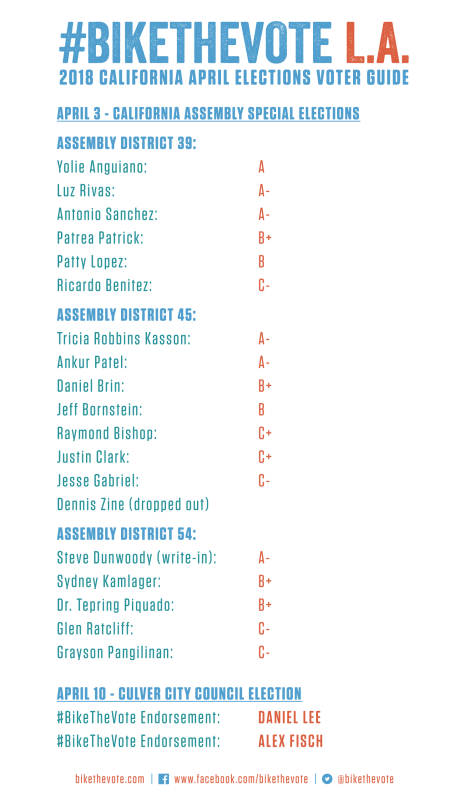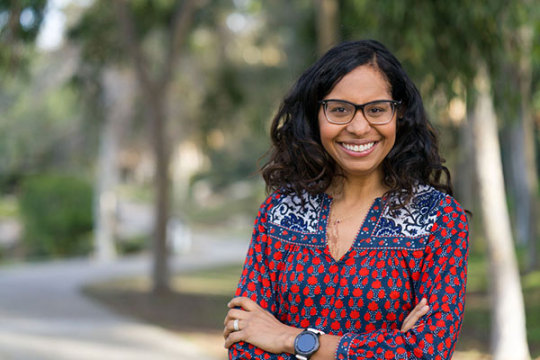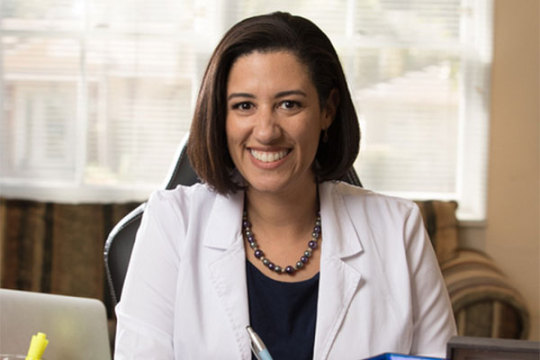Candidate campaign page: https://www.dunwoodyforcalifornia.com/
Steve Dunwoody has positioned himself as a progressive champion of the environment, and it is refreshing to see the pivotal role that active transportation plays in his platform. His response to Bike The Vote L.A. expressed a very thoughtful approach to centering transportation around quality transit complimented by transit-oriented development and first mile/last mile connections for those on foot and on bikes. (Note: Steve Dunwoody is running as a write-in candidate for the April 3rd special election, but plans to appear on the ballot as a candidate for the regular June 5th primary election.)
Bike The Vote L.A. 2018 Primary Grade: A-
(See below for full candidate questionnaire response)
1. The California Air Resources Board estimates that transportation accounts for 37% of California’s annual carbon emissions. What actions would you take as assemblymember to ensure that California creates a more sustainable transportation system?
One important way to reduce carbon emissions and pollution from the transportation sector is to push to convert our vehicles to operate on electricity, instead of fossil fuel.
We can start by electrifying public transit fleets such as buses and encouraging companies to do the same things for their fleets. It’s especially important that the regional goods movement system (especially around the ports) that currently rely on heavy-duty diesel trucks convert to no-emission and extremely-low emission standards.
Funding for this conversion was considered for inclusion in LA County’s Measure M but unfortunately was left out. The state ought to consider other ways to encourage it, as with SB 1204 (which, incidentally, was opposed by the district’s recently resigned Assemblymember). As we push to electrify passenger cars, it’s important that we integrate equity concerns from the start. I think we should build on pilot programs like BlueLA that bring car-sharing of electric vehicles to South LA, rather than subsidize wealthy purchasers of Teslas.
However, because the generation of electricity still produces emissions, until we achieve 100% renewable energy production, it is important to reduce overall energy consumption by the transportation sector.
The best way to do this is to increase the capacity of our public transit systems and to encourage equitable transit-oriented development. Bus rapid transit and light rail are important parts of this system and we must also include first mile/last mile improvements for pedestrians and cyclists to make the system a functioning, integrated whole.
2. Cap & trade funds offer a unique opportunity to prioritize sustainable transportation, particularly in low-income neighborhoods negatively affected by pollution caused by cars. Do you support dedicating a portion of cap and trade funds towards the Active Transportation Program to help fund better pedestrian and bicycle infrastructure?
Yes.
3. In Los Angeles, low-income communities of color are disproportionately burdened by the impacts of streets designed primarily for cars, without receiving proportional funding for their mobility modes like walking, biking, and public transit. Would you support legislation to add a ‘complete streets’ policy to SB 1, California’s newly augmented gas tax, to require all street and highway projects to incorporate the needs of pedestrians, bicyclists and transit-dependent communities?
Yes.
4. California law regarding the position bicyclists can occupy in a traffic lane is written in a confusing manner. The typical condition – in which the rightmost lane is too narrow for a car and a bicycle to travel safely side-by-side and the bicyclist is thus allowed to use the full lane – is written as an exception rather than the default standard. As a result, despite public information campaigns such as “Every Lane Is A Bike Lane,” there is frequently confusion from the general public and even law enforcement agencies on the legality of bicyclists riding in traffic lanes on California roads. Do you support re-wording traffic law to clarify the right of people on bikes to ride to maximize their visibility and safety?
Yes.
5. A recent study by the National Transportation Safety Board found that speeding was one of the most common factors in crashes, and one of the highest contributors towards fatal crashes. Despite this fact, speed limits across California are consistently raised due to a state law that sets speed limits at the 85th percentile of measured driving speeds. Do you support reform to the 85th percentile rule to give local jurisdictions the ability to set speed limits to better promote safe driving?
Yes.
6. California’s ongoing housing crisis challenges cities and communities to provide solutions towards meeting California’s demand for housing. Do you support efforts at the state level to accommodate smart growth, transit-oriented development, and sustainable communities that empower residents to get around on foot, by bike, and on quality public transit? What specific policies you would pursue to promote sustainable and affordable living for Californians?
Yes, I support such efforts at the state level that accommodate smart growth, transit-oriented development, and sustainable communities that empower residents to get around on foot, by bike, and on quality public transit.
Infill development and new housing, especially near transit is important to creating communities that are not auto-reliant.
At the same time, we can look to recent scholarship which shows that more market-rate development near transit without implementing measures to preserve and creating affordable housing, will lead to an exodus of low-income people who are core transit-riders.
So we must prioritize anti-displacement measures and the creation and preservation of affordable housing. Transit and transit-oriented development won’t achieve their potential if poor and working-class communities who are the highest propensity users of transit are displaced to the fringes of suburbia.
We need to make sure a significant percentage of new private housing development is dedicated to be permanently affordable to low-income families, especially near transit. There isn’t enough funding to build all the affordable housing our state needs, especially for those who are low-income. However by capturing the value created by building more densely, especially near transit, we can have private developers create a large share of the affordable units we need. For that reason, I support inclusionary zoning. Measure JJJ, passed by LA City voters in November 2016, is a good model to explore and build upon in this regard. It was the product of close collaboration between housing/community/renters rights groups, environmentalists, and labor.
I support strengthening rent control to control spikes in rental prices and give residents rights to stay in their homes as part of a comprehensive housing strategy. Repealing Costa Hawkins at the state level is crucial to giving localities the tools they need to do this.
And I believe funding from the cap-and-trade program should continue to support the sustainable communities programs, which includes affordable housing and green infrastructure.






